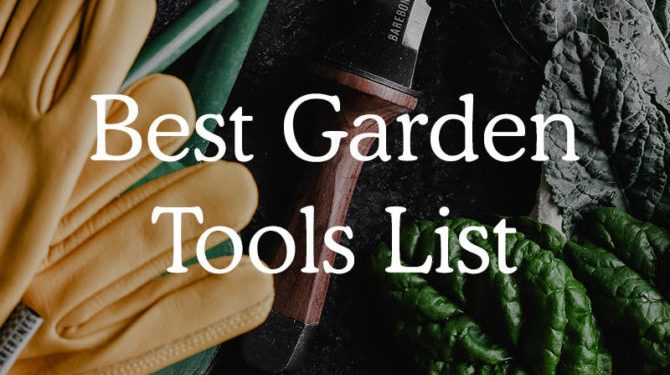When starting a garden it is important to know what the ultimate garden tools list is for all the projects and things you may experience. So we gathered up a list of the top garden tools for you to reference when you are in need of some one of these tools.
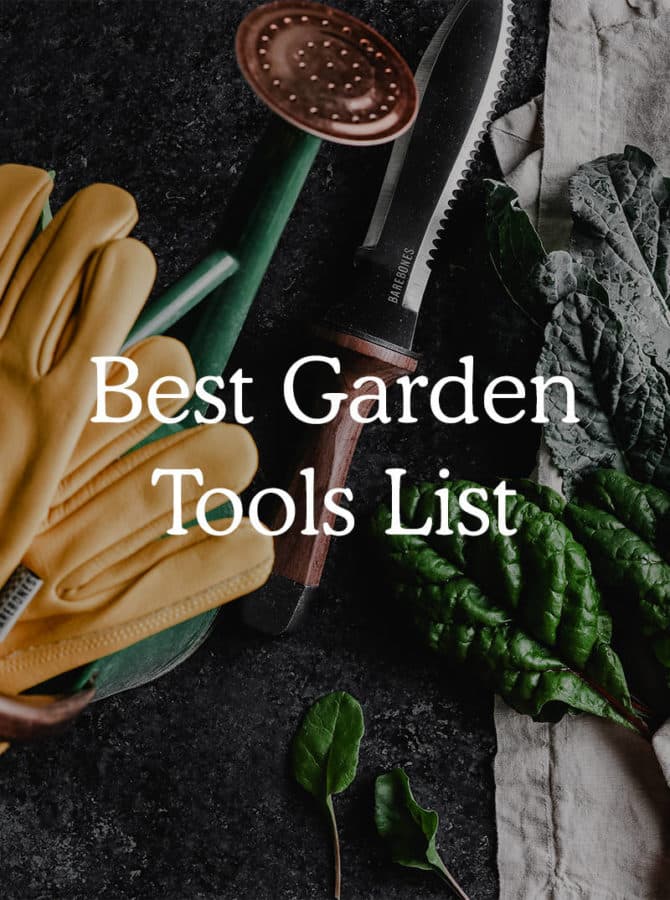
For years I have gardened and because of that I have been able to pull together a full garden tools list that gives you the best idea of the essential garden tools. This list is full of lots of tools for a lot of situations and you don’t need everything, but I would say all of them have legitimate reasons to be included in this list depending on the type of gardening you decide to do. If you are looking for a smaller and more beginner list of tools then I would suggest checking this post about my favorite essential garden tools.
This is the complete garden tools list that you may either encounter through your gardening adventures or you will want to add to your tool shed.
WANT TO SHOP ALL THE TOOLS? Head to our Amazon Shop for all the complete shopping list of garden tools.
Shovels, Spades, and Other Digging Tools
This is the complete list of tools for digging in the garden. They all serve various purposes depending on their shape and materials.
- Post Hole Digger: This is a unique situation digger but if you are going to be digging a hole for a post, you will want this digging tool in the garden. We used one in our DIY Garden Fence tutorial if you want to see a situation where you need one.
- Digging/Tamping Bar: This solid metal tool is for deep and serious digging. One end has a splitter and the other has a tamper. You would use this in the process of digging a hole for a post and to remove large rocks deep down.
- Bulb Planter: If you are doing tons of bulb planting this is the essential tool for it. It is marked precisely for making bulb hole digging very simple!
- Garden Trowel: This is one of the most common garden hand tools. It precisely moves soil for smaller shovel work.
- Transplanter: This one is similar to the garden trowel but it is even narrower. This one also offers marks for inches so you know depth.
- Round Point Shovel: Another almost necessary tool for gardening. This is a standard shovel that works for digging and moving soil.
- Square Point Shovel: This shovel is similar to a round point but this squared one is less for digging and more for moving materials.
- Garden Spade: This is the best shovel for edging and sod removal if you want to edge or create solid lines.
- Drain Spade: This is a narrower shovel for digging shallow trenches with more precision.
- Trenching Spade: similar to the drain spade but with a pointed bottom, which is a great tool for creating leverage.
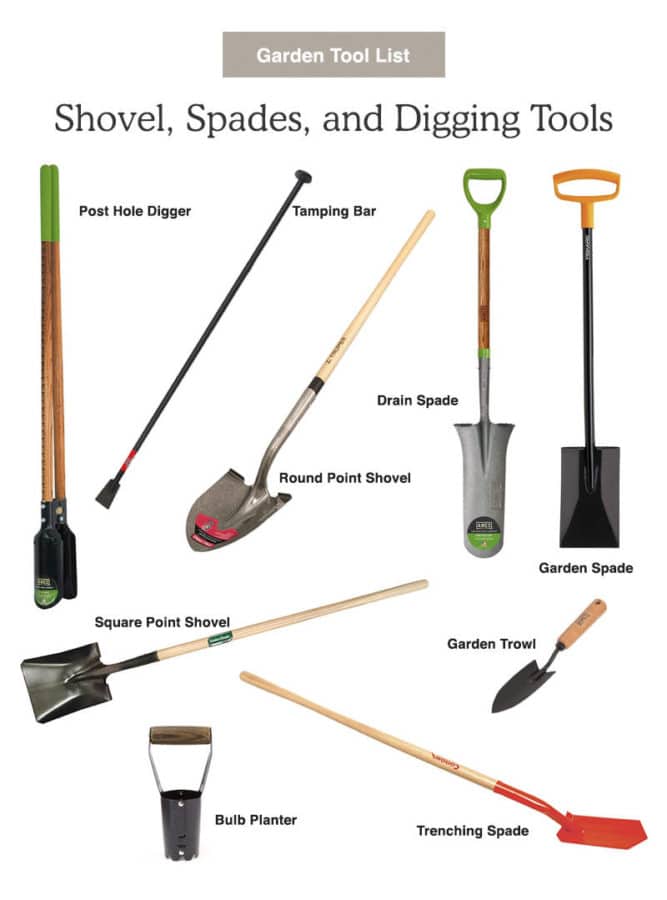
Rakes and Pitchforks:
These tools are really meant to move and grade things in the garden. We use them a lot early in the spring and late in the fall season. They even out soil or other materials or you can use them to aggitate the soil just enough to get in seeds.
- Leaf Rake: This is really intended for moving and shifting materials like dried leaves, grass clipping or more. The long tines made of preferably steel (holds up far longer) create the perfect hold on the materials to move them around where you desire them.
- Garden Rake: This class tool should be made of metal as this one will do a TON of work for you. If there is an essential tool in the garden this rake is it.
- Thatch Rake: This is an essential tool for growing a nice lawn space. It can remove old grass and open space for spreading more seed whether you use a fescue variety or a clover to improve nitrogen naturally.
- Bedding Fork: This tool is great for moving hay and more. Really you need one like this if you have animals that you are moving their bedding often.
- Manure Fork: This is a similar fork but it is stronger and designed to move heavier material like manure.
- Spading Fork: This can do much of what a bedding fork or a manure fork can do but works great in far more instances. I would say the spading fork is on the essential tools you need list.
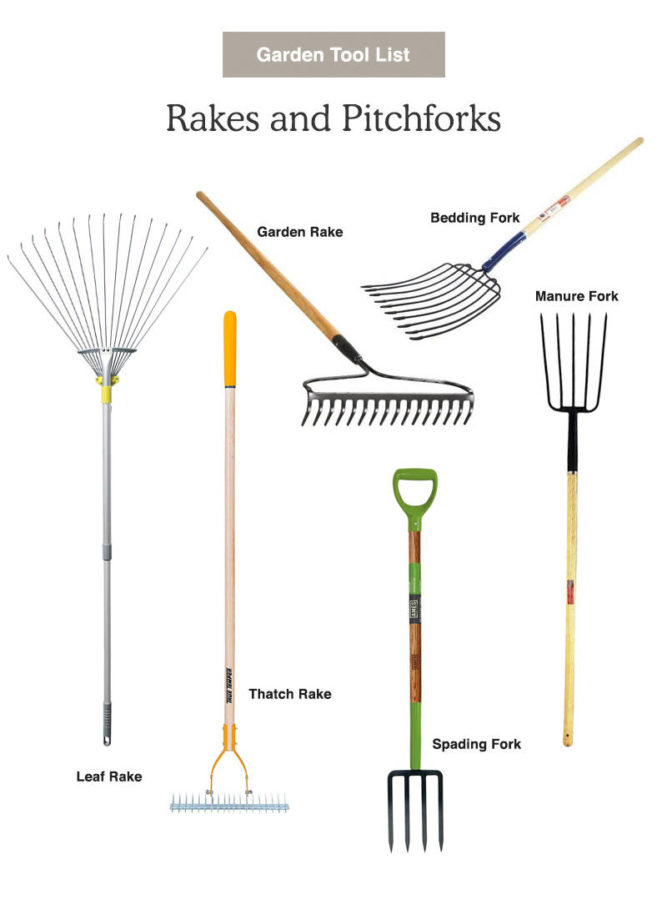
Tools for Watering the Garden:
The second most important thing to a great garden besides soil is your watering systems. Knowing what works and what doesn’t for your space is important. Below these are the top options for watering the garden.
- Watering Can: This hand held water carrier is the perfect way to do spot watering in hard to reach by hose areas or for smaller pots and such.
- Garden Hose: A hose of any size is ideal for watering. Choose a length that best suits your area.
- Spray Nozzle: A great nozzle that sprays in different strengths is ideal. You want to have at least a power, shower, and mister options for spray.
- Water Breaker: This nozzle creates a shower style or soaker type watering system which is great for pots and raised bed watering.
- Watering Wand: A hose attachment that extends the hose through a pipe and then through a spray head. Great for soaking in hard to reach areas.
- Hose Timer: These timers are awesome for someone who wants a low maintenance watering system. There are tons of styles and options to choose from to suit your needs. You can set them on timers and more.
- Drip Irrigation: This is a watering system that you setup and it uses permeable hoses to water the base of plants at their root system rather than overhead. It is great to avoid issues with mildew in particular.
- Sprinkler: A hose attachment that sprays overhead water to water plants.

Garden Hoes:
Yes there are enough Hoe tools in the garden we need to give them a separate header. Many of them will be on your essentials list. Particularly if you want to lower weeding and loosen soil without tilling.
- Standard Garden Hoe: This tool has a squared off blade that will cut through most things when used in a chopping motion. Great for loosening soil.
- Warren Hoe: This is the perfect hoe for planting rows of seeds. One end opens the ground while the other closes it.
- Weeding/Two-Prong Hoe: This tool has prongs to help get at the base of a weed and pull it out.
- Action Hoe: This is my favorite weeding tool in big open spaces where you don’t have to be as tedious. It comes with various lengths so it can be used standing or kneeling. The blade pivots back and forth and breaks weeds at the root base.
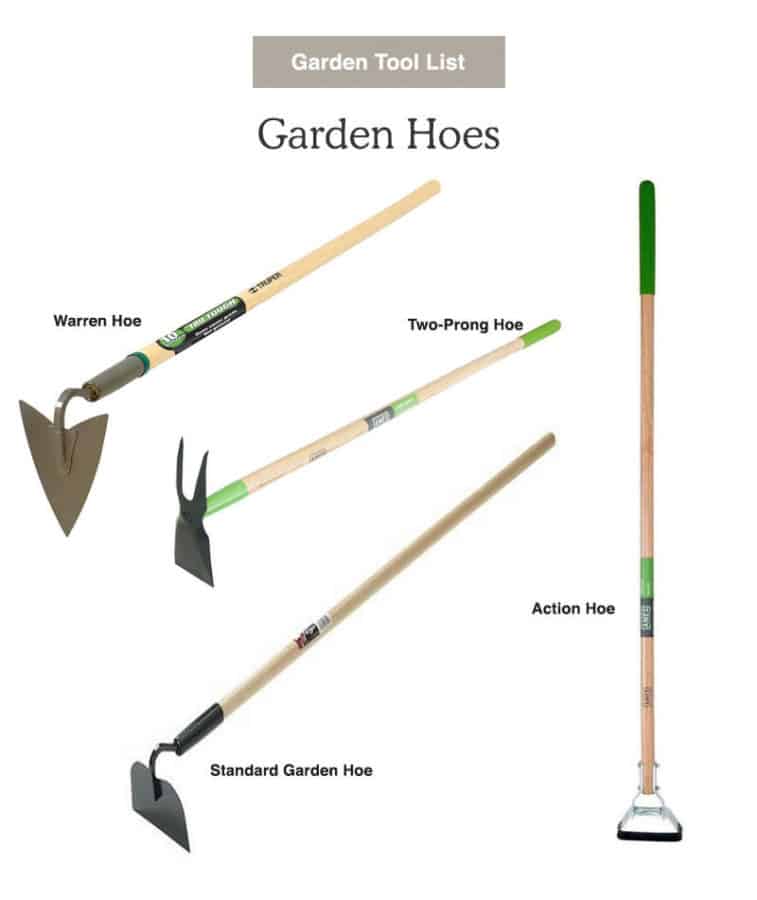
Saws and Other Pruning Tools:
Even in a small garden you will need some pruning tools and these are the most common ones you will want to consider, depending on the job at hand in your garden or yard.
- Pruning Saw: This is great to be used when on a ladder. If you are doing a small branch you will want smaller and tighter teeth. If you are doing a larger branch use larger teeth. It cuts on the pull so it makes it’s use much less awkward on a ladder.
- Bow Pruning Saw: This is great for chopping branches quickly. It is easy to hold in various positions because of the bow.
- Pole Pruner: This is used for out of reach or higher branches you want to cut. You will use the rope and pulley to use this tool to cut.
- Hand Pruner: This are hand held for quick trimming of branches and thicker stems of plants. They are as strong as most pruners but intended to be used in your hands.
- Lopper: This long handled pruner adds plenty of leverage to trim larger branches with weight and strength.
- Grass Shears: Perfect for more delicate and precise trimming where a string trimmer could hurt the surrounding plants.
- Hedge Shears: These are just what they say they are; trimmers for hedges. You can use these to trim and shape hedges.
- Garden Scissors/Snips: These are most common for the every day beginner gardener. I would label them as essential in your garden tools. These are perfect for trimming or harvesting in the garden.
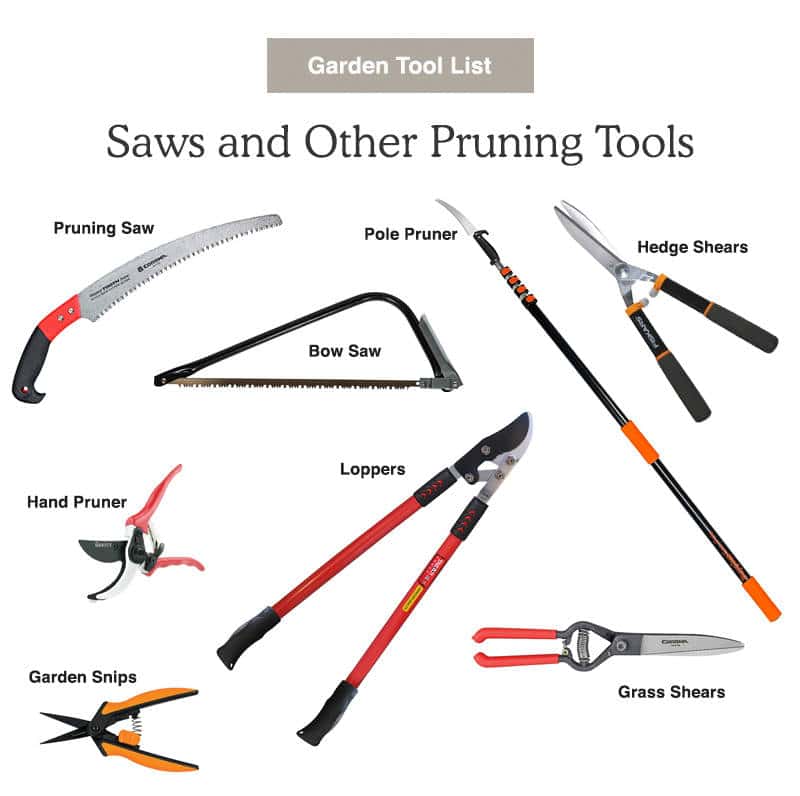
Other Landscape Tools:
These tools all are various styles and types for different jobs you may come across when landscaping and gardening. They serve various purposes in the garden, but are still considered common to need.
- Mattock: This tool comes with many options for the head depending on the type of work you are looking to do. They are used for breaking up soil and rocks or gravel areas in particular.
- Cultivator: similar to a tiller but with less agitation to the soil, these scratch the surface of the soil which is best prior to planting or seeding.
- Weeder/Grass Blade: This is another method for weed eating or trimming grass. You swing it back and forth as a blade. It is really awesome for large areas of land.
- Bush Axe/Briar Axe/Ditch Blade: This can be a super dangerous tool and should not be used with others in proximity. It looks like a battle axe because it is used to cut down thicker branches as you swing it through the brush.
- Edger: These are really helpful to edge and create clean lines in grass areas or along beds you want hard lines for aesthetic reasons.
- Handheld Weeder: This is used to get hard to pull weeds that have a good deep root system. You will use it for easy leverage to remove the weed.
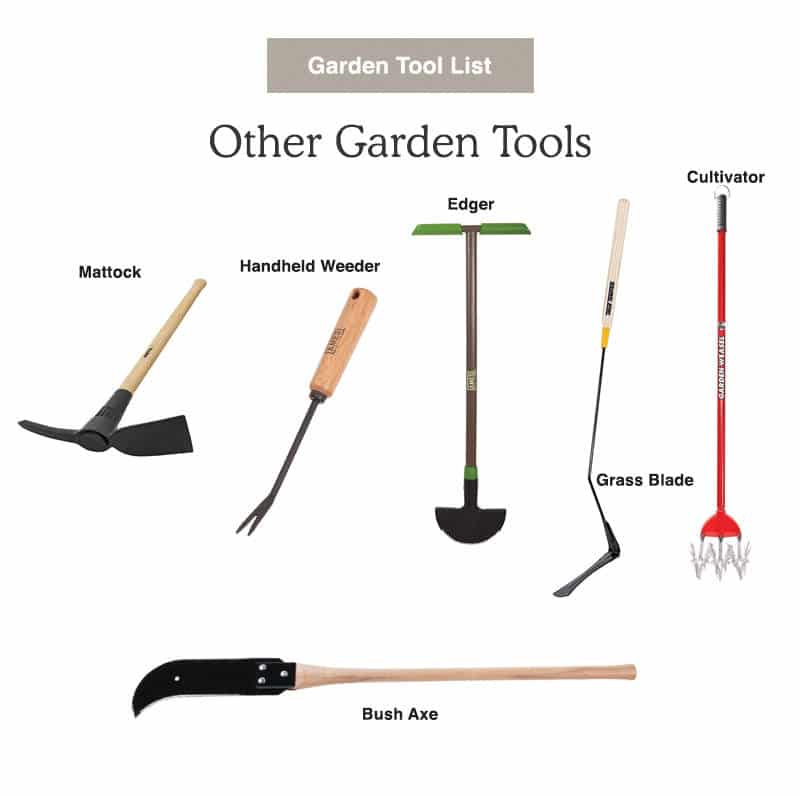
Wheelbarrows and Yard Carts
Moving mulch, compost, and soil is made easier with these tools. You will need one as an essential tool in your garden shed throughout the entire gardening season no matter the size of your garden.
- Wheelbarrow: These carts work off of one wheel with legs in the back. They can be very easy to move around lots of spaces but need level ground so they do not tip.
- Yard Cart:
These carts come in lots of sizes and styles. Some even fold up if that is something you are looking for.
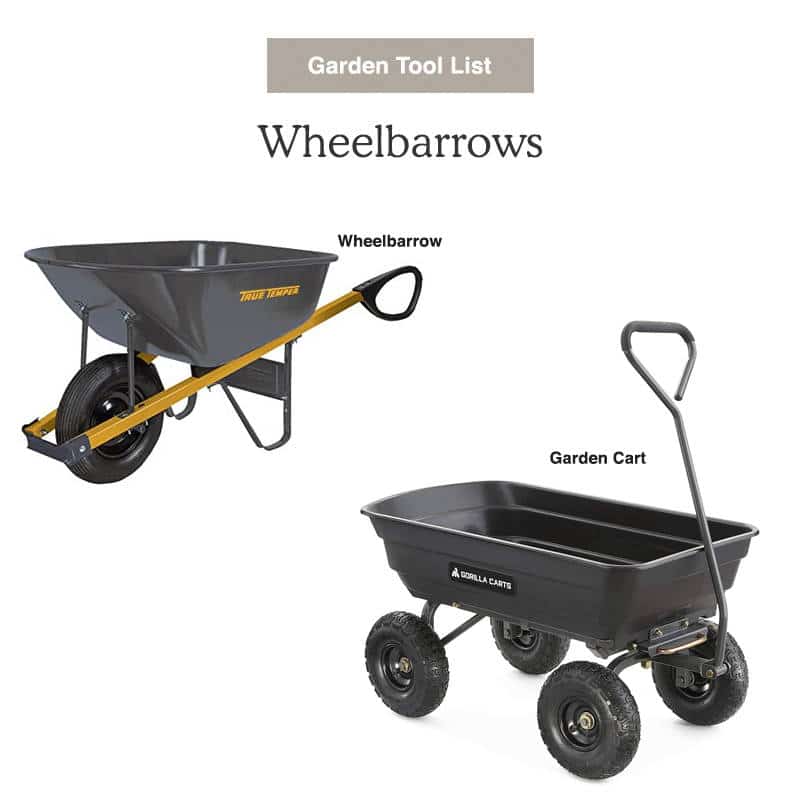
Conclusion
Though you won’t need every single tool on this complete garden tools list you will need enough that it is good to know and understand what you may be finding in the store. Knowing about these tools allows you to choose the proper tool for the job you have at hand in the garden whether you are a beginner or advanced in your garden.
Looking for more posts on Garden Tools?
My Favorite Essential Garden Tools
The Most Beautiful Garden Tools
Source by freshexchange.com
